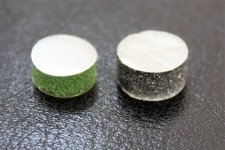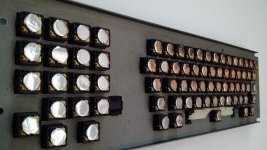So is the verdict that the post-July 4 pads actually don't work in a Sol? If this is true, does anyone have a source for replacement pads that will work in a Sol?
So if I've read Al's comment correctly, if I were to remove the shiny material from one of these foam replacements, on the shiny side I'd have no conductivity but on the side that was glued to the foam there would be conductivity? I took one foam pad apart, scraped away the foam residue on the glued side and tried a conductivity test... nothing on either side of the 'mylar' or whatever the shiny stuff used is.
Does this suggest there's something wrong with my keyboard since mine seems to prefer having the conductive side contact the PCB?
Sorry if I'm misunderstanding what's been said. I'm just wanting to clarify if I have a defect with the pads or the Sol itself.
Hello again everyone,
The conductive side (or metal/aluminum plated side) is supposed to be the side that is glued to the foam and the capacitive side faces the board/PCB. That is how they are put together.
So yes, trying to do an ohm test on the bottom of the pad will not show any results. The inside of the pad will pass an ohm test. However, trying to disassemble one will likely not work unless you are able to get all of the glue and foam left behind off. I just tried that myself and I also tried just sticking the probes in the pad against the aluminum side and it shows no reading. You have to conduct the test on clean material. Even if you tried to clean all the foam with something like rubbing alcohol it would also likely not pass an ohm test. If you could manage to get that dense foam and the glue off it would possibly also remove the aluminum plating from the mylar.
Here’s how I know this. On my very first batch of pads with this new material I actually did glue the mylar side down to the foam pad leaving the aluminum plating outward to touch the board. This is because I did an initial finger test (meaning I put the aluminum plated mylar on my finger and touched it to my Compaq board) and it responded wonderfully! I turned it to the mylar side and got nothing, well nothing consistent anyway. I could barely touch the metal plated side to the board and it would register a reading. I could swoop it across and make it dance on that board and it would register a reading meaning it would deliver a character to the screen. I thought, “WOW THIS IS AWESOME! Nothing like that old material I was using.” Which was, by the way, static bag material. I tested it the same way before I made pads and the static bag was never this “sensitive”. So I made a batch and installed them in my Compaq. I also spattered a heavy amount of glue on parts of the outside as it was windy outside and tried cleaning it with rubbing alcohol in those spots. I had to scrub it a lot. All the pads seemed to work great except for those that I cleaned too much…OR SO I THOUGHT! However, sometimes key presses would register multiple characters to the screen, I didn’t know what was happening, I just thought there was something else going on with my Compaq. So I made another batch so I could send them to my Lisa tester. I then tell him all about what I have done and how excited I am about how it is so sensitive, and this is what he tells me:
“Keep in mind that these are capacitive keyboards, not conductive. This means that the plastic side of the sheet needs to be outwards, touching the PCB. If you flip the conductive side towards the PCB, it will wear off quite quickly. Also, using your finger to press it onto the PCB isn't a good test, as your finger adds capacitance the same way an iPhone screen detects your finger. Gluing a piece to a pencil eraser would be a great test.”
I then respond be asking about how long it will last and dissatisfied because I want these to last forever! So he is, again, very patient with me and explains even more. Also, keep in mind, I already had some other nice gentlemen telling me all of this on the Apple Lisa group on Facebook prior to my first batch. I just wasn’t getting it! :D He says this:
“Yes. On a capacitive pad, you want only the plastic to touch the PCB. The metal on the other side acts as a capacitor, which the keyboard senses. It may work for a little while if flipped around, but the metal can wear off. Not just Lisa's, but all the Key Tronic keyboards should have the plastic side outwards. Some keyboards are just more sensitive to the materials than others. If we can find a good material that works well in the Lisa, it should work on all other keyboards also.”
He also sent me this nifty diagram:
https://texelec.com/wp-content/uploads/2018/07/Foam-Pad-Diagram.png
He then added this:
“Use a multimeter on the lowest resistance (ohms) setting. You'll find that one side is conductive, that's the metal side. The other side is not conductive, that's the plastic side.”
So I did and I just made a video doing this test for you on the material I am using on the pads. I tried tearing apart a pre-assembled pad but it is not showing a reading through the left over foam and glue so here it is before assembly:
https://texelec.com/wp-content/uploads/2018/07/Aluminum-Plated-Mylar-OHM-Test.mp4
I also did an ohm test on an original pad from my Compaq. The foam was still decent, and the glue was holding on pretty well so I didn’t scrub it too much as I didn’t want to remove any of the plating so the reading isn’t as strong as it would be on clean material:
https://texelec.com/wp-content/uploads/2018/07/Original-Foam-Pads-Pulled-from-Compaq-OHM-Test.mp4
I have heard back from my Lisa tester, who ended up being a different customer than the nice gentleman that helped me SO MUCH during construction. He just got too busy to work on his Lisa so I got someone else to get it tested for me. He was very thorough and had some critiques on the foam being more dense than the original. He only mentions this because he knows purists out there will want the same feel when hitting the keys which I understand. I like this foam because it will have an overall longer shelf life than open cell foam, I mention all of this in my blog post. Anyway, he did verify that every single pad worked, unlike the static bag material which was hit or miss for him as well. This is what he said on the Lisa group:
“I tested them in my Lisa keyboard, they all worked great. I have rebuilt a number of keyboards, at least 7 or 8. I think Sara's pads are the best option available. I usually purchase the foam pads, then build them myself, using the old parts from the degraded original pads. Unfortunately, the shipping alone for those foam pads is about $20. In addition, a lot of the time, the silvery colored mylar, is worn completely off. So, the old parts can't be used.”
I also heard back from Verault, who has posted on this thread as well and said every single pad worked, again, unlike the static bag material. I have received feedback from people on eBay as well but only 3 people (including Verault) mention the actual product. I think people order these and don’t get them installed right away. I really hope I will hear back from more people soon. I have sent all replacements out up to this point so maybe more from the Lisa group and eBay will give me feedback. Here is a link to my eBay feedback:
https://feedback.ebay.com/ws/eBayISAPI.dll?ViewFeedback2
Here is a link to my blog post where I talk all about the saga of the foam pads but there I did not go into all this capacitive/conductive detail. It was more an overall story from the original material I used and the final Lisa testing with the aluminum plated mylar. It also discusses other computers that the guys from the Lisa group were telling me about that used KeyTronic “foam and foil” pads:
https://texelec.com/2018/07/04/new-and-improved-foam-capacitive-pads-for-keytronic-keyboards/
A link to the Apple Lisa group (which is a closed group so you will need to join) post is below and in those comments you will also find a man who made his own pads and used them on Lisa’s, SOL-20s, Hyperions and a TRS-80, they were all the same pads. You will also see others explaining the capacitive versus the conductive sides on the post comments:
https://www.facebook.com/groups/1456236001309154/permalink/2132704983662249/
Here is a Deskthority article talking about KeyTronics keyboards that use the “foam and foil” capacitive pads:
https://deskthority.net/wiki/Key_Tronic_foam_and_foil
Here is a page that I hope will be updated someday to include my premade capacitive pads because there is a replacement available now that doesn’t include all the cleaning, cutting, punching and gluing! Maybe someday, one can hope.
 http://sol20.org/keyboard.html
http://sol20.org/keyboard.html
I started making these because of many articles I read about cutting foam gluing old plastic and using aluminum foil, mylar balloons, foiled wrapping paper, space blankets, etc. and painstakingly removing old materials and cleaning and gluing...and so on. I purchased a punch set and started making my own to fix old terminals and Compaq Portables as well as a Tandy or two along the way. You’ll see if you read my blog post.

Falter, I can’t help but think that your keyboard does have an issue outside of the foam pads needing to be replaced and I really hope that my very long-winded comment here has helped you understand the construction of the “foam and foil” pads and how they work. I know that I learned a lot myself in this process.
DavidL, if you were to buy a set of pads to fix your SOL I would be happy to accept a return if they did not work out for you and I would appreciate the testing on a SOL! I contacted a customer of mine earlier today when I read these new comments that I KNOW is going to be replacing his pads in a SOL. I will be happy to let you know when/if I hear back from him. He may even comment on this thread as he appears to have previously commented on this thread already.




